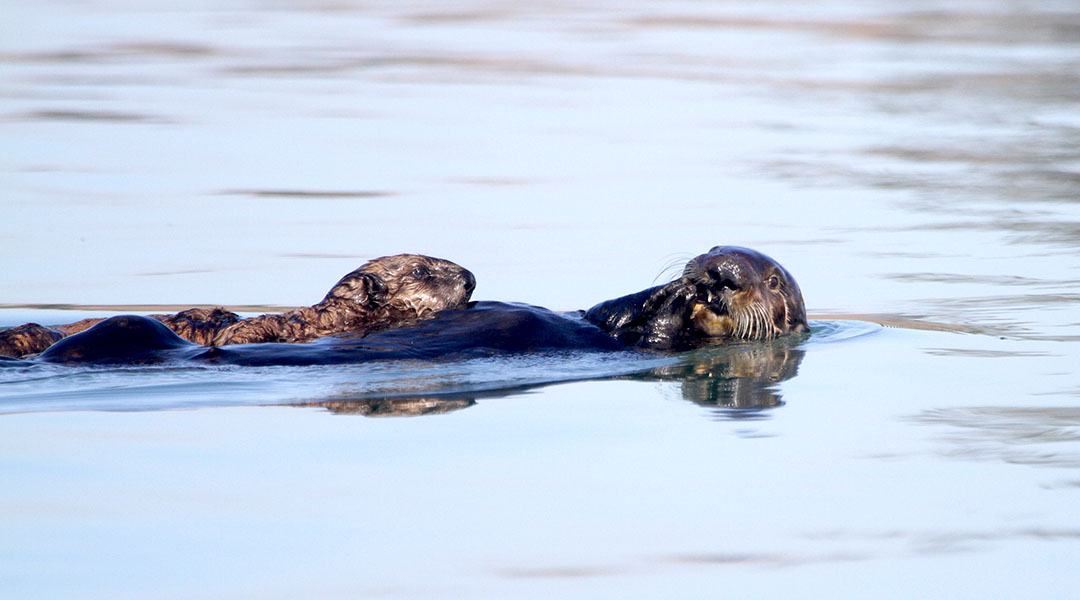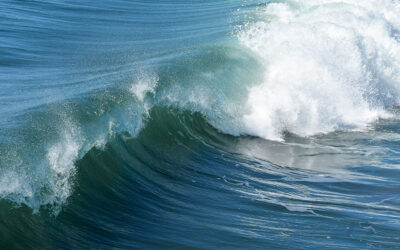Is a cute sea otter picture on Instagram robbing them of precious energy needed to live in the harsh marine environment?
In California sea otter populations are confined to a few locations after a long history of decline at the hands of humans. While they are no longer actively hunted their physiology leaves them extremely vulnerable to human disturbance. And because they live in areas where ecotourists also frequent these interactions are potential threat.
Sea otters adapted to deal with the cold marine conditions differently than other marine mammals like whales or dolphins. Instead of layers of blubber to insulate and keep warm otters use an extremely high metabolic rate, meaning they burn a lot of energy to maintain heat. They also have specialized fur which they can blow warm air into to act as insulator before they dive. “Air is a better insulator than fat,” said sea otter biologist Heather Barrett. “It’s the best one you can have if you can maintain it in a marine environment.”
To keep their fur and insulation in good condition the otters use up energy grooming and blowing air into the fur. This crucial activity, combined with their high energy demands, means the otters need to eat and sleep a lot.
“They have to eat a quarter of their body weight every day to maintain their internal body temperature and daily needs,” said Barrett. “For sea otters in areas with high disturbance and low prey availability, they’re on the knife’s edge calorically speaking, and can risk starvation.” Life on the edge therefore leaves little room for error and any wasted energy could prove fatal.
Barrett and other otter biologists who study the animals’ behaviours began noticing that recreational boaters often approached otters they were studying causing them to dive, or swim away. “That became an observation from a lot of sea otter biologists,” said Barrett. This observation led to action.
To determine the costs of these disturbances Barrett, along with biologists and volunteers with the research and outreach non-profit Sea Otter Savvy embarked on a comprehensive five year study to identify and quantify the costs of human disturbance on these vulnerable creatures.
Step one was assessing the who, when and how, regarding disturbance. Studying these questions in sea otters specifically raised several challenges. In other species like birds, researchers use trackers or tags to monitor an individual’s movement and heart rate. “Although sea otters have been tagged in past projects, we were not in a position to pursue this method for this research, and we had concerns regarding how this would impact the sea otters in a disturbance study,” explained Barrett. Not only is this difficult it creates the exact type of disturbance that the researchers believe can be harmful. “We didn’t want to cause distress in collecting data,” said Barrett. The best option then was public viewing stations and a cadre of biologists and citizen scientists.
At several locations along the California coast, trained researchers and volunteers would sit and observe otter behaviour. During these so-called behavioural scanning sessions, the observers are trained in a standardized method of recording otter behaviour. They also recorded any stimulus that affects that behaviour and the distance between the stimuli and otters.
After five years and 853 scanning sessions Barrett and colleagues had a plethora of data with which to paint a picture of the natural, and anthropogenic, disruptions to otter daily life. This picture, created with a blend of observation and modelling revealed several insights crucial for conservation guidelines.
The first is that most disturbance is caused by small-sized recreational boats. “There are occasions with fishermen,” said Barrett, “but by far, it was kayakers, those wanting to go recreate, photograph sea otters, and go to sea otter habitat,” she said. “So, you’re seeing recreational disturbance.”
The second insight was distance. Modelling results showed that there is steep increase in the probability of disrupting an otter, something that causes it to change task and swim, dive, or hide, for example, as the stimulus moves closer. For Barrett and the team this was a useful result. “We can actually start to see distance guidelines from this,” she explained. “Distance matters, and it has a physiological cost to sea otters.”
That cost could now be calculated for any given day. Coupling the behavioural observations with known data about the metabolic rates of sea otters they could calculate how much energy disturbance was costing an otter. What they found was that at some sites an otter could lose 435 kilojoules in a day which could equally roughly 3% of the daily requirements.
To give the public a better understanding of what the means the researchers converted this into the amount of food they would need to compensate for this loss. “Just for one day, it corresponds to about three northern kelp crabs, or 22 Pacific little neck clams, or 41 snails, or 18 purple urchins that are greater than two centimetres,” said Barrett. And while 3% may not sound like a lot the effects add up over time. “If that ends up being what happens to you every day for a week, and you’re a female, lactating with a pup, that’s a big deal,” Barrett said.
In fact, in a previous study investigating causes of female sea otter mortality over 50% of deceased female sea otters between 2005-2012 succumbed to end lactation syndrome which is essentially starvation from caring for pups. “Females will basically do everything for their pup and starve to death right in the process,” Barrett said.
Barrett believes that studies like this, which demonstrate a tangible cost to behaviour, better motivates outdoor enthusiast to behave better. Sea Otter Savvy used the data to produce distance guidelines which they distribute to tour operators and other business in sea otter ranges. They also built a community active wildlife stewards program in these communities so the local business and residents help to teach visitors about sea otters and disturbances.
“Humans are the most difficult aspect to this puzzle, our own personalities, our behaviour,” said Barrett. “I think past wildlife management, is always about, let’s change the behavior of the animal to best fit practices. And I think now we’re starting to understand, and what we hope to teach people is to become stewards and understand that it’s our behaviour that can change.
Reference: Heather E. Barrett, et al. Energetic cost of human disturbance on the southern sea otter (Enhydra lutris nereis), The Journal of Wildlife Management (2025). DOI: 10.1002/jwmg.70012
Feature image credit: Heather E. Barrett

















